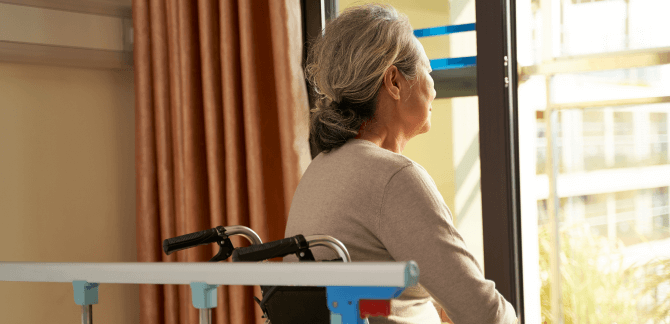What Is Elder Abuse?
Elder abuse is an act or lack of action that harms an older person. Sadly, elder abuse is an all-too-common problem. Elders are vulnerable to abuse when they need to rely on caregivers such as family, friends, or nursing home staff.
Elder abuse can take many forms, including physical injuries, financial exploitation, and verbal threats.
Up to 5 million older people are abused every year, according to the National Council on Aging (NCOA). Elder abuse increases an older person’s risk of death threefold.
Further, the World Health Organization (WHO) reports higher rates of elder abuse in nursing homes than in community settings. Elder abuse is never acceptable, yet it still happens every single day.
If you or a loved one has suffered from abuse, don’t wait to take action. Reporting elder abuse can put a stop to the harm being done and hold perpetrators accountable.
You can also take legal action to seek financial aid for medical bills and other expenses.
Types of Elder Abuse
There are several types of elder abuse. While some types of abuse may not leave physical marks, all of them can greatly harm older people.
Common types of elder abuse include:
- Neglect: Ignoring an older person’s personal needs
- Physical abuse: Punching, kicking, shoving
- Sexual abuse: Unwanted kissing, fondling, or rape
- Emotional abuse: Yelling, name-calling, or using slurs
- Financial exploitation: Stealing money or other things of value
Older people may suffer from more than one type of elder abuse at the same time. For example, elders who are sexually abused may also suffer from physical and emotional abuse.
The National Center on Elder Abuse (NCEA) recognizes 7 different types of elder abuse. Learn more about each type below.
Physical Abuse
Physical elder abuse is the improper and intentional use of physical force against an elder, resulting in bodily impairment, pain, injury, or harm.
Physical elder abuse may include:
- Restraint: Restricting the movement of an elder physically or by the inappropriate use of medications
- Rough handling: Being unnecessarily rough with an older person, such as during bathing or dressing
- Violence: This includes actions like punching, pushing, or grabbing
Sexual Abuse
Any non-consensual sexual contact with an older person is elder sexual abuse.
Sexual elder abuse may include:
- Sexual assault: Unwanted touching or other sexual activities with an elder
- Unwelcome advances: Sexual harassment and unwanted verbal sexual propositions
- Sexual activity without consent: Any sexual contact with an elder who has been ruled unable to grant informed consent due to conditions like Alzheimer’s, who is not conscious, or who did not expressly consent to sexual activity
Financial Abuse
Elder financial abuse occurs when someone takes money or assets from an older person without their consent, full knowledge, and/or understanding. The NCOA notes that financial abuse costs elders between $2.9 billion and $36.5 billion each year.
Financial elder abuse may include:
- Coercion and abuse of power: Using a position of power or trust to get an elder to change their will or make financial transactions
- Stealing assets: Forging signatures of an elderly person, committing identity theft, or using an elder’s credit card to make purchases or withdraw cash
- Taking control of assets: Getting property deeds, accessing an inheritance, or taking other actions to acquire an elder’s assets
Emotional Abuse
Psychological or emotional elder abuse refers to attempts to intimidate, demean, or belittle an older person.
Emotional elder abuse may include:
- Verbal abuse: Shouting, cursing at, insulting, or bullying
- Threats: Threatening to harm an elder, withhold health care services, or isolate them
- Isolation: Cutting an elder off from their friends, family, and social networks
- Limiting choices: Robbing an elder of their independence by limiting their freedom to choose everyday activities
Neglect


Elder neglect happens when a caregiver fails to meet the expected needs of an older adult. Neglect can be just as dangerous as other types of abuse.
In 2019, seven nursing home employees in Ohio were charged with a variety of crimes after residents were injured or died under their supervision.
The Ohio attorney general noted that one resident “literally rotted to death” due to untreated wounds — a clear example of nursing home neglect.
Self-Neglect
This occurs when an older adult who can no longer take care of themselves refuses or does not seek help, leading to a decline in wellbeing. Common signs of elder self-neglect include poor personal hygiene, a dirty living environment, and untreated health problems.
Abandonment
Elder abandonment occurs when the caretaker of an older adult permanently deserts them. Nursing home residents are at risk of abandonment if the facility illegally evicts them.
According to a 2019 report from NBC News, thousands of elderly residents are ejected from nursing homes on a yearly basis. In 2018, over 1,400 people filed complaints about wrongful nursing home evictions in California alone.
Elder Abuse Causes
Caring for older people can be emotionally taxing and stressful — even for trained professionals. This can cause caregivers to make mistakes or take their frustrations out on the very people they need to care for.
For example, relatives who are forced into a caregiving role may abuse or neglect older adults if their relationship with them is strained.
Learn more about common causes of elder abuse below:
-
Caretaker Stress
Both professional and family caretakers can burn out or become overstressed while caring for an elderly person. In turn, they may take their stress out by abusing or neglecting the senior they’re supposed to help.
-
Cultural and Familial Influences
How caretakers and families view elders can impact the likelihood of elder abuse. A culture’s tolerance toward violence and expectations of family members in regard to caring for elders can also have an effect.
-
Understaffing in Nursing Homes
Many nursing homes do not have enough caretakers to adequately meet the needs of all residents. This lack of staffing means that caretakers are often expected to work long hours for low wages, increasing stress and exhaustion. This may cause staff to skip important care steps and take longer to respond to care requests.
The Centers for Disease Control and Prevention (CDC) also notes that nursing home staff may be more likely to commit abuse due to issues like a lack of well-trained staff, burnout, and a high-stress work environment.
Remember, though: there is never a good reason for nursing home staff members or other caregivers to abuse older people. Those who abuse elders need to be brought to justice.
Warning Signs of Elder Abuse
Since there are many types of elder abuse, signs that an older person has been abused can vary. It’s important for loved ones to understand the many possible signs of elder abuse to protect older people.
Warning signs of elder abuse can include:
- Bedsores (also known as pressure ulcers)
- Broken bones or sprains
- Cuts, bruises, and/or scrapes
- Dehydration or malnutrition
- Lack of prompt medical care for health issues
- Medication overdoses
- Poor hygiene (dirty clothes and/or hair)
- Strange emotional changes (anxiety, fear, social withdrawal)
- Unexplained falls
- Weight loss
If you notice any signs of abuse while your loved one is living in a nursing home, contact our team today. You can pursue justice and compensation to keep your loved one safe.
Elder Abuse Risk Factors
While elder abuse can happen to anyone, certain factors put some older people at a higher risk. Women, for instance, are more likely to suffer from elder abuse than men, according to the U.S. Office on Women’s Health.
Some elder abuse risk factors include:
-
Mental Impairments
The NCEA found that nearly 50% of older Americans that suffer from dementia have been abused. These adults also have a harder time reporting abuse due to their impairment.
-
Poor Physical Health
Elders with physical health issues may be at greater risk as they are more dependent on other people. This means they may be more likely to give in to threats or coercion out of fear of losing support. Also, they may not be able to defend themselves against abuse or leave an abusive situation.
-
Shared Living Situation
The World Health Organization (WHO) reported that elders may be at greater risk for abuse if they are in a shared living situation where there are more opportunities for conflict between a caretaker and an older adult.
-
Social Isolation
Seniors who are socially isolated may be more likely to be manipulated by an abuser due to loneliness and less likely to report elder abuse. Isolated elders may also be at higher risk because there are fewer people around to notice the abuse.
Other elder abuse risk factors include a lower income or economic background, being over the age of 65, and having suffered abuse in the past.
Effects of Elder Abuse
Elder abuse has devastating effects on victims and their loved ones.
Consequences of elder abuse include:
- Disabilities: Some physical injuries or illnesses that stem from elder abuse (such as bedsores or broken bones) can take months or years to heal from. In some cases, older people may become permanently disabled due to the harm they’ve suffered.
- Financial ruin: Elder financial abuse can leave older people that are trying to pay for food, housing, and medication penniless. Most elders do not have the opportunity to earn new income and rely on their savings to survive.
- Medical bills: Elders and their family members may face expensive medical bills due to injuries stemming from abuse or neglect.
- Job loss: Family members or relatives may need to quit their job to provide temporary or full-time health care to an older loved one who was abused.
- Psychological distress: Victims of elder abuse are more likely to become depressed, fearful, or anxious. As a result, they may isolate themselves or even attempt suicide. Knowing that an older loved one has suffered from elder abuse can also place a lot of stress and guilt on their family.
- Death: The worst cases of elder abuse can cause or contribute to an older adult’s death.
All forms of abuse can have awful consequences, so it is important to quickly get help if you suspect abuse has occurred.
We can help if your loved one suffered nursing home abuse or neglect. Get started with a free case review.
Who Commits Elder Abuse?
Anyone is capable of committing elder abuse. However, the NCOA found that nearly 60% of all perpetrators of elder abuse and neglect are family members.
Some caretakers — even those with good intentions — may be more likely to mistreat an elder.
Caretakers are at greater risk of committing elder abuse if they:
- Are not trained or well-prepared for caregiving
- Financially depend on the elder
- Have little or no access to caregiving services, such as respite care
- Have negative beliefs about aging and elders
- Have substance abuse or mental health problems
- Lack social and emotional support
Thankfully, older people and their loved ones can bring abusive caregivers to justice.
Elder Abuse in Nursing Homes
Elders in nursing homes face unique risks. Sadly, 1 in 10 seniors have suffered some type of abuse.
Elder abuse in nursing homes may occur because:
- Living in a shared space puts nursing home residents in close contact with many people, including potential abusers.
- Many nursing homes suffer from understaffing, increasing the likelihood of abuse and neglect.
- Residents often need special care for mental and physical disabilities. These traits make them more vulnerable and put them at higher risk of abuse.
A study of over 2,000 nursing facility residents found a nursing home abuse rate of 44% and a 95% rate of neglect.
Preventing Elder Abuse
While there’s no foolproof way to make sure elderly loved ones are never abused, there are ways to help prevent elder abuse.
The risk of elder abuse may be lowered by:
- Checking in with an older person often and listening to what they need
- Helping older people run errands and manage appointments
- Reporting possible cases of abuse as soon as possible to authorities
- Offering to help and support caregivers to prevent burnout
- Seeking immediate aid if an elderly person has mental health impairment or an addiction
- Teaching yourself and loved ones how to spot signs of elder abuse
Remember: The most effective way to stop elder abuse is to prevent it from happening in the first place.
Reporting Elder Abuse


If elder abuse does occur, it should be reported as soon as possible. Reporting elder abuse can help get your loved one out of harm’s way and protect others as well.
Elder abuse can be reported to:
- A local long-term care ombudsman (for elders in assisted living)
- Adult Protective Services (APS)
- An elder abuse hotline
- Law enforcement
- Nursing home abuse lawyers
Sadly, a study by the National Research Council estimated that only 1 in 14 elder abuse cases are reported to authorities. Though elder abuse is highly dangerous, older people may not report it due to fear of retaliation or mental/physical impairments.
In these cases, loved ones may need to step up and report abuse on the elder’s behalf.
Ombudsman for Elder Abuse in Nursing Homes
Elders in long-term care facilities or their loved ones can report abuse through their local ombudsman.
A nursing home ombudsman is a representative of residents and their families. Their job is to protect elders from potential abuse or neglect and work to resolve care complaints.
A long-term care ombudsman may protect elders through:
- Advocacy: Working directly with nursing home residents, family members, and nursing homes to address issues that elders and their loved ones may have
- Investigation: Visiting nursing homes and reporting their findings regarding the quality of care to local, state, and federal governments
They can address any residents’ complaints, ranging from food quality to cases of nursing home abuse and neglect, and will work to resolve them.
Elder Abuse Attorneys
Once you’ve reported elder abuse to 911 or a senior advocacy organization, it may be wise to contact a nursing home abuse law firm.
Nursing home abuse law firms deeply understand the issues facing your family, and their attorneys will work with you to hold abusers financially responsible. Some lawyers have secured over $1 million for families in past cases.
Take action against elder abuse in nursing homes. Call (855) 264-6310 to get connected with top elder abuse attorneys.
Take Legal Action Against Elder Abuse
It’s horrifying to learn that an older person you love has suffered from elder abuse — and the consequences can be terrible. Fortunately, you can start to rebuild after elder abuse by filing a nursing home abuse lawsuit.
Filing an elder abuse lawsuit may:
- Compensate elders and their families for financial losses, medical expenses, and hardship
- Lower the chance that an abuser will harm others
- Hold those who take advantage of elderly people accountable for their actions
Remember, elder abuse is never the fault of the victim. You and your family deserve compensation and peace of mind when abuse occurs.
To see if you may be able to file a lawsuit against someone who has committed nursing home abuse, get a free case review today.
Elder Abuse FAQs
How many older Americans suffer abuse?
It’s believed that up to 5 million older Americans suffer from abuse or neglect every year. The exact numbers are hard to pinpoint as elder abuse often goes unreported.
Who commits elder abuse?
Almost anyone can commit elder abuse, such as strangers, the staff of nursing homes and assisted living facilities, hired home caregivers, friends, and even family.
In fact, the NCOA notes that family members are the abusers in nearly 6 out of 10 cases. Resentment, fatigue, and stress are common complaints of individuals who are not physically or emotionally prepared to be care providers.
What is the most common type of elder abuse?
Psychological mistreatment or emotional abuse is the most common form of elder abuse, according to a 2020 study from the WHO:
- 1 in 3 residents or their family members reported instances of psychological abuse in nursing homes
- Similarly, nearly 1 in 3 nursing home staff members admitted to emotionally abusing residents in the study
In nursing home settings, sexual abuse was the least common type, though these cases often go unreported.
What laws are in place to stop elder abuse?
There are both federal and state laws that aim to keep elders safe from abuse. State laws define what elder abuse is and outline punishments for those who commit it.
Federal laws like the Older Americans Act and the Nursing Home Reform Act help make sure that all residents receive the same level of care.
What kind of crime is elder abuse?
This depends on the type of elder abuse that has been committed. While some cases of neglect that result in minor injuries may be considered misdemeanors, serious instances of abuse may be felonies.
In 2021, a South Carolina nursing home employee was arrested after he exposed his genitals to an elderly female resident. He was charged with third-degree criminal sexual conduct, a felony in the state.
How can attorneys help me after elder abuse occurs?
Elder abuse attorneys can help you and your family hold abusive caregivers accountable by filing nursing home lawsuits.
These lawsuits will demand that the abusers (typically the nursing home and its staff) pay financial compensation for harming your loved one.
Attorneys also understand how elder abuse laws may impact your case. The U.S. has laws like the Older Americans Act and the Elder Justice Act to protect older people.
All states also have laws called statutes of limitations that limit the amount of time you have to file an elder abuse lawsuit. Attorneys can ensure that your case is filed before time runs out.


